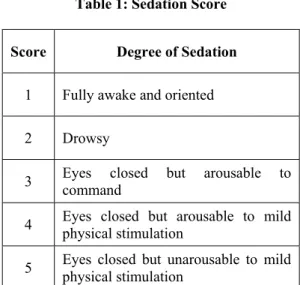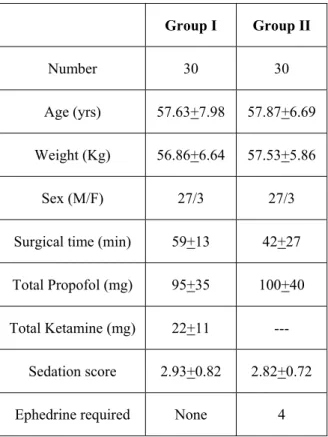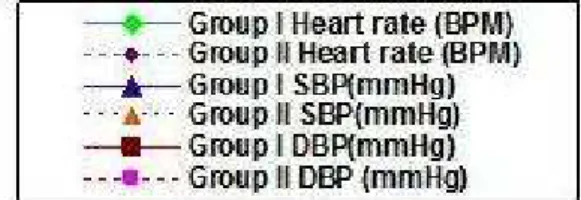Internet Journal of Medical Update
Journal home page: http://www.akspublication.com/ijmu
Original Work
Circulatory responses to propofol-ketamine combination compared to
propofol alone for sedation during spinal anesthesia
Showkat Nengroo
*ΨMD, Abdul Qayoom Lone
†MD and Imtiaz Naqash
‡MD
*
Assistant Professor,
†Additional Professor,
‡Professor, Department of Anesthesiology
and Critical Care, Sher-i-Kashmir Institute of Medical Sciences, Srinagar, Kashmir,
India
(Received 10 March 2010 and accepted 23 December 2010)
ABSTRACT: The present study was undertaken to establish the efficacy of low dose propofol-ketamine infusion in maintaining hemodynamic stability when used for sedation as compared to propofol alone during spinal anesthesia. Sixty adult patients of either sex, belonging to ASA physical status I and II undergoing urological procedures were studied in a randomized manner. After administering spinal anesthesia with 0.5% bupivacaine, patients were assigned to two groups of 30 patients each. Group I (propofol-ketamine combination) received intial loading dose of propofol and ketamine followed by a continuous infusion of low dose propofol and ketamine whereas group II (propofol alone) received a bolus dose of propofol followed by a continuous infusion of propofol only. Hemodynamic parameters like heart rate, systolic blood pressure, diastolic blood pressure and sedation scores rated on a five point scale were recorded at baseline and at the predetermined intervals of 5, 10, 15, 20, 25, 30, 45, 60, 75 and 90 minutes after spinal anesthesia. It was found that heart rate, systolic and diastolic blood pressure was significantly higher in group I patients at various intervals as compared to group II patients, however sedation scores revealed no significant difference at different time intervals between the two groups. In conclusion propofol-ketamine combination was found to confer hemodynamic stability during spinal anesthesia as compared to propofol alone.
KEY WORDS: Spinal anaesthesia; Sedation; Propofol; Ketamine; Circulatory responses
INTRODUCTIONᴪ
Regional Anaesthesia is becoming an increasingly important aspect of anaesthesia practice. It offers several benefits to the patients including cardiovascular and respiratory stability, preservation of airway reflexes and rapid postoperative recovery1. Some of the drawbacks of regional anesthesia however include fear of needles and pain at the puncture site2 and recall of the procedures3. These factors stress the importance of sedation during surgical procedures done under regional anaesthesia. Sedation has been shown to increase patient satisfaction during regional
ᴪCorrespondence at: Department of
Anesthesiology and Critical Care, Sher-i-Kashmir Institute of Medical Sciences, Srinagar, Kashmir, India; Email: inaqash@rediffmail.com
anaesthesia and may be considered as a means to increase the patient acceptance of regional anaesthetic techniques4.
An ideal sedative is one that safely provides relief from pain, anxiety and unpleasant memories for a wide variety of procedures. Several sedative and analgesic drugs have been used singly or in combination5-8 but no one regimen meets all of the above requirements.
sympathetic nervous system and reduces the incidence of spinal anaesthesia induced hypotension11.
Propofol and ketamine administered in combination from separate syringes has been used successfully in a variety of settings including spinal anesthesia12. This combination has been favored because of the opposing hemodynamic and respiratory effects of each drug9. The combination has also been shown to reduce the dose of propofol required to achieve sedation13 and is believed to result in less toxicity than either drug alone because their complementary effects enable the use of lower doses of each drug14.
With this background we decided to compare the effect of propofol-ketamine combination to propofol alone on hemodynamics when used as a sedative adjuvant to spinal anaesthesia.
METHODOLOGY
After approval from the hospital ethical committee and written informed consent from the patients, 60 ASA physical status I and II patients of either sex, aged 18 to 75 years undergoing spinal anesthesia for urological procedures were enrolled for the study. Patients with a history of allergic reaction to propofol and ketamine, obesity, significant central nervous system, cardiac, pulmonary, hepatic and renal disease were excluded from the study. Patients were randomly allocated to two groups of 30 patients each. Group I (propofol-ketamine combination group) and Group II (propofol alone group). The patients were premedicated with tablet Alprazolam 0.25mg in the morning on the day of the surgery.
On arrival to the operating room, patients were connected to Datex cardiocap monitor for monitoring of ECG, heart rate and NIBP. O2
saturation was monitored with Pace-Tech pulse oximeter. Baseline measurements of heart rate, systolic and diastolic blood pressures were recorded prior to administration of spinal anesthesia and then at 5 minutes intervals for first 30 minutes of surgery and every 15 minutes thereafter till a total duration of 90 minutes. After preloading the patients with 6ml/kg of Ringer lactate, spinal anesthesia was given with hyperbaric bupivacaine 0.5% in sitting position using 24 G spinal needle, in doses sufficient to provide a satisfactory sensory block for the procedure to be done. The sensory block was evaluated after every 3 minutes using a cold swab until the level was sufficient for the surgery to begin.
Immediately after spinal anesthesia, patients assigned to group I received an intial loading dose of propofol 0.4mg per kg and ketamine 0.1mg/kg followed by a continuous infusion of 1.2mg/kg/hr
only followed by a continuous infusion of 1.5mg/kg/hr. The study drugs (Propofol or admixture of propofol-ketamine) were prepared by an anesthesiologist not involved in the study and the anesthesiologist assessing the level of sedation was blinded to the sedative infusion being administered. The level of sedation was recorded every 5 minutes and subsequent infusion rates titrated to maintain the sedation score at or around level 3 on a five point sedation score as shown in table I. The sedative infusion was stopped during the surgical procedure if the respiratory rate fell to less than eight breaths per minute, the infusion otherwise was discontinued at the end of surgical procedure. Total sedative and vasopressor requirements were noted. Oxygen was administered through a face mask to those patients who exhibited a SpO2 of 95% or less. Observations were
continued in the recovery room till a total duration of 90 minutes from the start of surgery. Patients re-mained in the recovery room until sensory functions returned to normal.
Table 1: Sedation Score
Score Degree of Sedation
1 Fully awake and oriented 2 Drowsy
3 Eyes closed but arousable to command
4 Eyes closed but arousable to mild physical stimulation
5 Eyes closed but unarousable to mild physical stimulation
The data was collected, tabulated and statistically analyzed using the student’s t-test. Values were expressed as mean + SD and a p value of <0.05 was taken as significant and p <0.001 as highly signifi-cant.
RESULTS
maintained throughout the procedure. Four patients in group II experienced a hypotensive episode and needed ephedrine supplementation for treatment of hypotension.
Table 2: Demographic variables of the patients in the two groups
Group I Group II
Number 30 30
Age (yrs) 57.63+7.98 57.87+6.69 Weight (Kg) 56.86+6.64 57.53+5.86
Sex (M/F) 27/3 27/3
Surgical time (min) 59+13 42+27 Total Propofol (mg) 95+35 100+40
Total Ketamine (mg) 22+11 ---
Sedation score 2.93+0.82 2.82+0.72 Ephedrine required None 4
Values are expressed as mean+SD
Changes in heart rate and arterial blood pressure after the spinal anesthesia and sedative administration are shown in figure 1. It has been observed that the changes in the heart rate in the two groups did not differ significantly at predetermined intervals during the procedure. On the other hand both systolic and diastolic blood pressures remained significantly higher in group I patients, when compared to group II patients at similar time intervals. There were no significant differences in respiratory rate, SpO2 and the need
for oxygen supplementation between the two groups.
DISCUSSION
Spinal anesthesia is one of the commonest techniques of regional anesthesia. The impediments to the effective use of spinal anesthesia are the predictable decreases in arterial blood pressure and heart rate through the accompanying sympathectomy with its attendant vasodilatation
and blockade of cardio accelerator fibres. Another clinically important impediment to successful block is inadequate sedation.
The goals of sedation during spinal anesthesia are to provide an adequate level of sedation while minimizing pain and anxiety, maximizing amnesia, minimizing the potential for adverse drug-related events, controlling behavior, and maintaining a stable cardiovascular and respiratory status.
Propofol infusion provides excellent sedation during spinal block. The advantages to its use are that the technique is safe, simple, depth of sedation can be easily altered and recovery is within 5 minutes after stopping the infusion14. However it has some properties that limit its usefulness. It causes reduction in myocardial contractility and in peripheral vascular resistance, leading to reduction of mean arterial pressure. However, ketamine has a stimulant effect on intact sympathetic nervous system which may offset the depressant effect of propofol.
A number of studies have demonstrated that the combination of ketamine and Propofol for sedation is safe and effective. The combination of the two agents appears to reduce side effects of each medication used alone, and allows for a rapid recovery time15. Hence we decided to evaluate the effectiveness of the propofol-ketamine combination for sedation and maintenance of stable hemodynamics. We observed that propofol-ketamine combination as an infusion provided a comparable sedation to propofol only and the hemodynamics remained stable during spinal anaesthesia with propofol-ketamine infusion as compared to patients receiving propofol only. Our results correlate with those of Frizelle et al who demonstrated that propofol-ketamine combination, given as infusion during spinal anesthesia, provided hemodynamic stability12. Similar results were also obtained by Guit et al, who recommended propofol-ketamine combinations for TIVA also when stable hemodynamics are required16.
Hemmingsen et al in their study observed that during spinal anesthesia patients could be kept hemodynamically stable by intravenous administration of ketamine11.
CONCLUSION
REFERENCES
1. Asehnoune K, Albaladejo P, Smail N, et al. Information and anesthesia: what does the patient desire? Ann Fr Anesth Reanim. 2000 Oct;19(8):577-81.
2. Lonsdale M, Hutchison GL. Patient’s desire for information about anesthesia. Scottish and Canadian attitudes. Anesthesia. 1991 May;46(5):410-2.
3. Macario A, Weinger M, Carney S, et al. Which clinical anesthesia outcomes are important to avoid? The perspective of patients. Anesth Analg.1999 Sep;89(3):652-8.
4. Wu CL, Naqibuddin M, Fleisher LA. Measurement of patient satisfaction as an outcome of regional anesthesia and analgesia: a systemic review. Reg Anesth Pain Med. 2001 May-June;26(3):196-208.
5. Gilbert J, Holt JE, Johnston J, et al. Intravenous sedation for cataract surgery. Anesthesia. 1987 Oct;42(10):1063-69.
6. Ferrari LR, Donlon JV. A comparison of propofol, midazolam and methohexital for sedation during retrobulbar and peribulbar block. J Clin Anesth. 1992 Mar-Apr;4(2);93-6. 7. Yee JB, Schafer PG, Crandall AS, et al.
Comparison of methohexital and alfentanil on movement during placement of retrobulbar nerve block. Anesth Analg. 1994 Aug;79(6):320-3.
8. Rosenberg MK, Raymond C, Bridge PD. Comparison of midazolam/ketamine with
methohexital for sedation during peribulbar block. Anesth Analg. 1995 Jul;81(1):173-4. 9. Friedberg BL. Propofol-ketamine technique:
dissociative anesthesia for office based surgery ( a 5 year review of 1264 cases). Aesthetic Plast Surg. 1999 Jan-Feb;23(5):70-5.
10. Smith I, Monk TG, White PF, et al. Propofol infusion during regional anesthesia: sedative, amnestic, and anxiolytic properties. Anesth Analg. 1994 Aug;79(2):313-9.
11. Hemmingsen C, Neilson JE. Intravenous ketamine for prevention of severe hypotension during spinal anesthesia. Acta Anaesthesiol Scand. 1991 Nov;35(8):755-7.
12. Frizelle HP, Duranteau J et al. A comparison of propofol with a propofol-ketamine combination for sedation during spinal anaesthesia. Anesth Analg. 1997 Jun;84(6):1318-22.
13. Mourad M, El-Hamamsy M, Anwar M, et al. Low dose ketamine reduces sedative doses of propofol during ambulatory transoesophageal echocardiography. Egypt J Anesth. 2004;20:41-6.
14. Camu F, Vanlersberghe C. Pharmacology of systemic analgesics. Best Pract Res Clin Anesthesiol. 2002 Dec;16(4):475-488.
15. Mackenzie N, Grant IS. Propofol for intravenous sedation. Anaesthesia. 1987 Jan;42(1):3-6.


